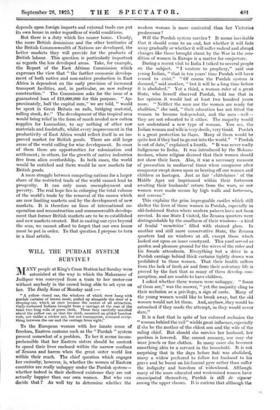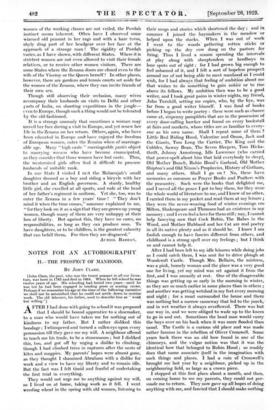WILL THE PURDAH SYSTEM SURVIVE
MANY people at King's Cross Station last Sunday were astonished at the way in which the Maharanee of Jodhpur was conveyed from a train to her motor-car without anybody in the crowd being able to set eyes on her. The Daily News of Monday said :- " A yellow closed car, the windows of which were hung with purdah curtains of brown mesh, pulled up alongside the door of a sleeping-car, which at once became the centre of all attraction. Gaily-turbaned Indians brought from a carriage at the rear of the train two long rolls of green cloth. These they carefully unrolled about the yellow car, so that the cloth, mounted on gilded bamboo rods, not rmlike a cricket net, but not transparent, screened every- thing between the car and the carriage from sight."
To the European woman with her innate sense of freedom, Eastern customs such as the " Purdah " system present somewhat of a problem. To her it seems incom- prehensible that her Eastern sisters should be content to spend- their lives enclosed within the narrow confines of Zenana and harem when the great outer world lies within their reach. The chief question which engages her curiosity, however, is, whether the women of Eastern countries are really unhappy under the Purdah system— whether indeed in their sheltered existence they are not actually happier than our own women. But who can decide that ? As well try to determine whether the modern woman is more contented than her Victorian predecessor !
Will the Purdah system survive ? It seems inevitable that it should come to an end, but whether it will fade away gradually or whether it will suffer radical and abrupt changes like those brought about by the War in the con- dition of women in Europe is a matter for conjecture.
During a recent visit to India I talked to several people on the subject. " I venture to prophesy," said one young Indian, " that in ten years' time Purdah will have ceased to exist." " Of course the Purdah system is doomed," said another, " but it will be a long time before it is abolished." Yet a third, a woman ruler of a great State, who herself observed Purdah, told me that in her opinion it would last at least two hundred years more. " Neither the men nor the women are ready for abolition," she said, " their education has not fitted the women to become independent, and the men—well- they are not educated to it either. The majority would not understand a new type of woman. You see, the Indian woman and wife is very docile, very timid. Purdah is a great protection to them. Many of them would be quite lost if they had to go out into the world." " Purdah is out of date," explained a fourth. " It was never really indigenous to India. It was introduced by the Moham- medans, whose religion decreed that their women should not show their faces. Also, it was a necessary measure of precaution in mediaeval times when conqueror after conqueror swept down upon us bearing off our women and children as hostages. Just as fair ' chatelaines ' of the Middle Ages sat imprisoned within their fortresses awaiting their husbands' return from the wars, so our women were made secure by high walls and fortresses, and screens."
This explains the grim impregnable castles which still shelter the lives of those women in Purdah, especially in old-fashioned States where modern palaces have not been erected. In one State I visited, the Zenana quarters were distinguishable by the smallness of their windows—a kind of feudal ' meurtribe ' filled with stained glass. In another and still more conservative State, the Zenana quarters had no windows at all, except those which looked out upon an inner courtyard. This yard served as garden and pleasure ground for the wives of the ruler and his female attendants. Everything but a drive in a Purdah carriage behind thick curtains tightly drawn was prohibited to these women. That their health suffers from the lack of fresh air and from their sedentary life is proved by the fact that so many of them develop con- sumption, and are unable to have children.
I asked whether these women were unhappy. " Some of them are," was the answer, " yet the majority cling to their seclusion as a privilege, a sign of caste. Many of the young women would like to break away, but the old women would not let them. And, anyhow, they would be ostracised if they made the attempt, so they would never dare."
It is a fact that in spite of her enforced seclusion the "woman behind the veil" wields great influence, especially if she be the mother of the eldest son and the wife of the ruling chief. But should she survive her husband, her position is lowered. She cannot remarry, nor may she wear jewels or fine clothes. In many cases she becomes something akin to a servant in the household. It is not surprising that in the days before Sati was abolished, many a widow preferred to follow her husband to his grave and be burnt on his funeral pyre rather than suffer the indignity and boredom of widowhood. Although many of the more educated and westernised women have emancipated themselves, Purdah is still de rigueur among the upper classes. It is curicus that although the women of the working classes are not veiled, the Purdah instinct seems inherent. Often have I observed some Wizened old peasant in her rags and with a bare torso, shyly drag .part of her headgear over her face at the approach of a strange man ! The rigidity of Purdah varies, as I have shown, with different States. Where it is strictest women are not even allowed to visit their female relatives, or to receive other women visitors. There are some States where the Zenana doors are closed even to the wife of the Viceroy or the Queen herself ! In other places, however, there are gardens and tennis courts set aside for the women of the Zenana, where they can invite friends of their own sex.
Though still observing their seclusion, many wives accompany their husbands on visits to Delhi and other tarts of India, on shooting expeditions in the jungle— even to Europe, though such a thing would not be tolerated by the old-fashioned.
It is a strange anomaly that sometimes a woman may unveil her face during a visit to Europe, and yet renew her life in the Zenana on her return. Others, again, who have been educated in Europe and have enjoyed the freedom of European women, enter the Zenaha when of marriage- able age. Many "high caste " marriageable partis object to marrying women who have become emancipated,. as they consider that those women have lost caste. Thus, the westernised girls often find it difficult to procure' husbands of suitable rank.
In one State I visited I met the Maharajah's small' daughter dressed as a boy and riding a bicycle with her brother and an English governess. A sturdy, healthy little girl, she excelled at all sports, and rode at the head of her father's regiment in uniform. Yet she, too, was to enter the Zenana in a few years' time ! " They don't mind it when the time comes," someone explained to me, " for they look on it as a sign that they are grown up young women, though many of them are very unhappy at their loss of liberty. But against this, they have no cares, no responsibilities, as long as they can produce sons. To have daughters, or to be childless, is the greatest calamity that can befall them. For then they are disgraced."
AURIOL BARRAN.



















































 Previous page
Previous page